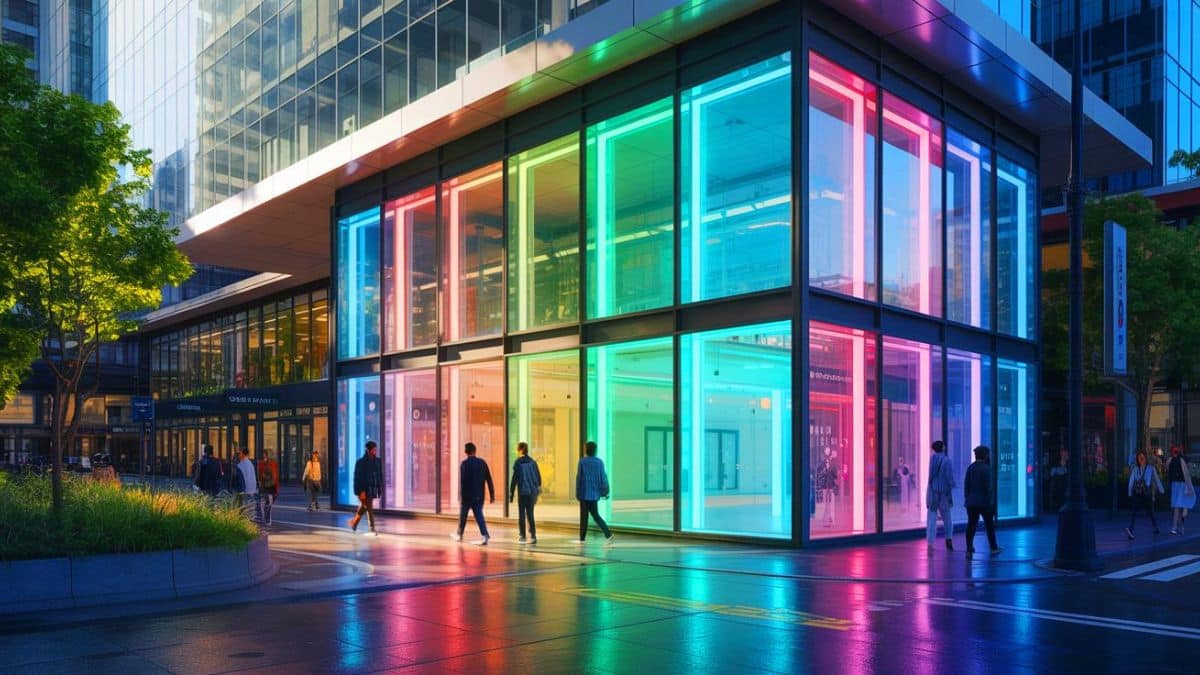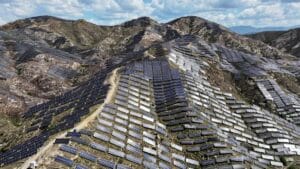The innovation in window technology from Korea’s Advanced Institute of Science and Technology (KAIST) marks a significant breakthrough in urban building efficiency. This smart window system, called RECM (Reversible Electrodeposition and Electrochromic Mirror), demonstrates remarkable ability to reduce indoor temperatures by up to 27°C while simultaneously managing glare for pedestrians outside buildings.
Revolutionary smart window technology transforms urban environments
Buildings consume approximately 40% of global energy, with windows being a major source of energy loss. The KAIST research team’s smart window innovation addresses this challenge through active control of light and heat transmission via electrical signals, unlike conventional windows that passively respond to environmental changes.
The RECM technology represents a substantial advancement over traditional smart windows by incorporating a unique electrochromic structure that regulates both visible light and near-infrared radiation. This allows for precise management of indoor climate conditions and glare reduction, creating more comfortable urban spaces.
What makes this technology particularly innovative is its ability to eliminate the reflection-caused glare that has plagued traditional metal-deposition based smart windows. By integrating electrochromic materials with a refined deposition process, researchers have created a “pedestrian-friendly” smart window ideal for urban settings.
The applications extend beyond just buildings to include:
- Commercial office towers
- Residential high-rises
- Public transportation vehicles
- Train carriages
- Sustainable urban infrastructure
In China, a mountain range disappears under a sea of solar panels – creating the largest photovoltaic landscape ever deployed in the world
At 11 years old, she discovers a giant marine reptile that had been sleeping beneath our feet for 200 million years
Triple-mode functionality delivers unprecedented climate control
The RECM smart window operates in three distinct modes, each serving different environmental needs and comfort requirements. This versatility makes it exceptionally adaptable to changing weather conditions and user preferences.
In transparent mode, the window allows sunlight and heat to pass freely, providing natural warmth during colder months. When privacy and temperature regulation become priorities, the window transitions to a deep blue tint through activation of electrochromic materials that absorb a portion of light and heat while maintaining visibility.
The most innovative aspect comes in reflective mode, where a silver coating forms on the glass, reflecting a significant amount of sunlight and heat while the blue tint reduces glare for pedestrians outside. This three-mode system gives buildings a dynamic tool for managing light, heat, and glare throughout the day.
| Mode | Primary Function | Best Used For |
|---|---|---|
| Transparent | Maximum light transmission | Cold weather or low-light conditions |
| Blue Tint | Temperature regulation and privacy | Moderate sun exposure situations |
| Reflective | Heat reflection and glare reduction | Intense sunlight or high temperature conditions |
According to Professor Hong Chul Moon of KAIST, who authored the study, this research transcends traditional smart window technologies that focus solely on visible light control. It creates a platform that actively manages indoor temperatures while enhancing visual safety for pedestrians in urban environments.
They dumped 200,000 radioactive barrels into the Atlantic: French researchers launch an unprecedented mission to track them down
Goodbye smartphones: Mark Zuckerberg announces the end date — and what will replace them
Dramatic temperature reduction proven in real-world testing
The effectiveness of the RECM technology was demonstrated through experiments with a miniature model house. When equipped with conventional glass windows, the interior temperature soared to 58.7°C in just 45 minutes. However, with the RECM window set to reflective mode, the temperature remained significantly lower at 31.5°C—a remarkable reduction of approximately 27.2°C.
This dramatic temperature difference highlights the potential energy savings in air conditioning costs during hot weather. For urban environments where heat island effects intensify summer temperatures, this technology could provide substantial relief and contribute to more sustainable city planning.
The impact of this innovation extends beyond comfort to address pressing environmental concerns. By reducing the energy demand for cooling, these smart windows can:
- Decrease greenhouse gas emissions from power generation Lower peak electricity demand during heatwaves Extend the lifespan of cooling systems Improve indoor comfort without increasing energy consumption Reduce urban heat island effects in densely populated areas
As cities worldwide face increasing temperatures due to climate change, KAIST’s smart window technology represents a promising advancement in building science that could help transform urban landscapes into more energy-efficient and comfortable environments for future generations.







